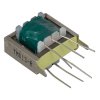wanttaja
En-Route
I've got an ICOM handheld installed in my panel as the only radio in the open-cockpit aircraft. It has an 8-ohm output impedance for the headphone portion.
This summer, I've been using ear buds underneath my leather helmet. With the approach of fall, I've switched back to using my Flightcom Denali ANR headsets. With cooler weather, it's more comfortable with a traditional headset holding the helmet flat against my head rather than the "airscoop" effect that otherwise occurs.
But I got spoiled this summer. With the 8-ohm earbuds on the 8-ohm output, I had very good volume and sound quality. Using the standard 300-ohm aircraft headset for the first time this year really highlighted how much volume the mismatch costs.
So...I'm looking at some options, to regain the impedance match in a traditional headset. So far, I'm thinking:
1. Buy a non-aviation set of ANR headphones and add a mike boom. I like this approach, but am concerned about passive noise attenuation...am worried commercial headphones won't get anything near the attenuation one can get from even a non-ANR headset.
2. Buy a headset configured for US military use (9-ohm speakers). These use a different plug, but I can probably find an adaptor or replace the plug. I believe I'd have to replace the mike, too.
3. Buy a non-ANR headset, and get a Headsets Inc ANR adaptor for a military headset. These come with the lower-impedance speakers.
4. Buy an aviation ANR headset that includes an 8-ohm MP3 input to the headphones, and wire the aircraft radio to that connector instead.
The last option would let me use the headset for those rare occasions I fly in an airplane with a conventional radio (just BFRs, mostly).
So...any other ideas? Suggestions?
Ron Wanttaja
This summer, I've been using ear buds underneath my leather helmet. With the approach of fall, I've switched back to using my Flightcom Denali ANR headsets. With cooler weather, it's more comfortable with a traditional headset holding the helmet flat against my head rather than the "airscoop" effect that otherwise occurs.
But I got spoiled this summer. With the 8-ohm earbuds on the 8-ohm output, I had very good volume and sound quality. Using the standard 300-ohm aircraft headset for the first time this year really highlighted how much volume the mismatch costs.
So...I'm looking at some options, to regain the impedance match in a traditional headset. So far, I'm thinking:
1. Buy a non-aviation set of ANR headphones and add a mike boom. I like this approach, but am concerned about passive noise attenuation...am worried commercial headphones won't get anything near the attenuation one can get from even a non-ANR headset.
2. Buy a headset configured for US military use (9-ohm speakers). These use a different plug, but I can probably find an adaptor or replace the plug. I believe I'd have to replace the mike, too.
3. Buy a non-ANR headset, and get a Headsets Inc ANR adaptor for a military headset. These come with the lower-impedance speakers.
4. Buy an aviation ANR headset that includes an 8-ohm MP3 input to the headphones, and wire the aircraft radio to that connector instead.
The last option would let me use the headset for those rare occasions I fly in an airplane with a conventional radio (just BFRs, mostly).
So...any other ideas? Suggestions?
Ron Wanttaja








